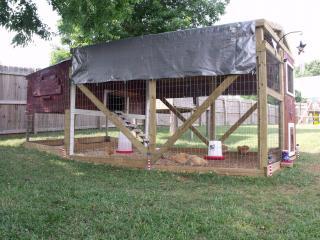Hi,

I am interested in learning more about the deep litter method.
Background:
- I am a first time chicken owner.
- I have 13 hens and 1 roo
- I have an enclosed pen and run.
This is how I have been cleaning my coop...
1. take out all old shavings
2. use leaf blower to blow out all dust and hidden poop
3. use hose to spray out coop
4. spray down coop with bleach solution
5. use hose again to wash out bleach solution
6. put down insect dust on coop floor
7. put clean shaving in coop.
Here is a pic of my coop and run if helpful.

I do this every month. Not only is it wearing me out but the used litter is starting to stack
up around here. There has got to be an easier way.

I ran across the deep litter method, don't know much about it. My questions are...
1. How does this work.
2. Do you really only have to clean the coop 1-2 times a year?
3. How much litter do you add when adding new litter?
4. How healthy is this for the chickens?
please, please explain to me how this method works. I need something that is much more simple.
Thanks

I am interested in learning more about the deep litter method.
Background:
- I am a first time chicken owner.
- I have 13 hens and 1 roo
- I have an enclosed pen and run.
This is how I have been cleaning my coop...
1. take out all old shavings
2. use leaf blower to blow out all dust and hidden poop
3. use hose to spray out coop
4. spray down coop with bleach solution
5. use hose again to wash out bleach solution
6. put down insect dust on coop floor
7. put clean shaving in coop.
Here is a pic of my coop and run if helpful.

I do this every month. Not only is it wearing me out but the used litter is starting to stack
up around here. There has got to be an easier way.

I ran across the deep litter method, don't know much about it. My questions are...
1. How does this work.
2. Do you really only have to clean the coop 1-2 times a year?
3. How much litter do you add when adding new litter?
4. How healthy is this for the chickens?
please, please explain to me how this method works. I need something that is much more simple.
Thanks



